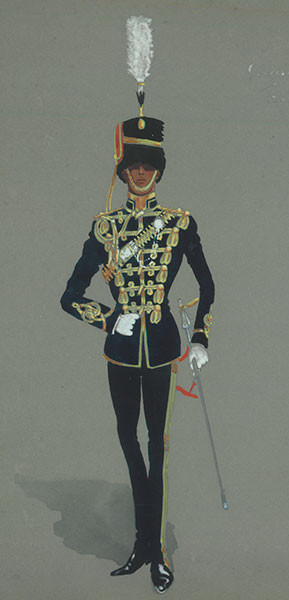This cavalry regiment was raised in Hertfordshire in 1715 in response to the Jacobite Rebellion. It was known by several names until 1751, when it was established as the 10th Regiment of Dragoons – Dragoons being soldiers who moved on horseback but fought on foot. The Regiment was again retitled in 1783 by King George III and from then on was known as the 10th (Prince of Wales’s Own) Regiment of (Light) Dragoons. The king’s eldest son, in whose honour the Regiment had been renamed, became its Colonel in 1796. The Prince of Wales was a great admirer of the colourful uniforms of the French cavalry and once again set about renaming the Regiment and redesigning its uniform in 1806. The newly named 10th (Prince of Wales’s Own) Regiment of (Light) Dragoons (Hussars) became Britain’s first ever Hussar unit – Hussars being soldiers who both moved and fought on horseback. The Prince of Wales remained Colonel of the Regiment until his coronation as George IV in 1820.
The Regiment fought at the Battle of Waterloo (1815) and was again deployed during the Crimean War, seeing action in the Siege of Sevastopol (1854-1855). In 1861, the Regiment was yet again renamed the 10th (The Prince of Wales’s Own Royal) Hussars and two years later gained another Prince of Wales, the future King Edward VII, as its Colonel. Under the new name the Regiment fought in the Second Anglo-Afghan War (1878-1880) and the Second Boer War (1899-1902). It was deployed to India in c. 1905 and to South Africa in mid-1912. The Regiment is accredited with introducing the Indian game of polo to England in 1834.
Hussars had a reputation for being dashing, adventurous and slightly reckless. They were distinguished by their unusually handsome and often colourful uniforms, inspired by those worn by Hungarian cavalrymen. The 10th Hussars were no exception. They were commonly called ‘The Shiny 10th’ or ‘The Chainy 10th’ from the chain mail epaulettes worn by the officers and the elaborate cross belt which formed part of the uniform.
10th Hussars | Becoming a Hussar | Service in British India | Service in South Africa | Meet the Hussars

